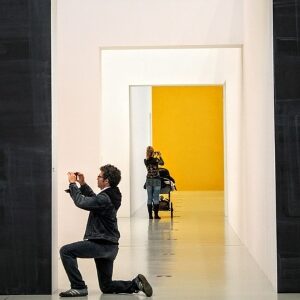The Magic of Glass: Celebrating Artistic Innovations
By Marie Deshayes
Is the magic of glass’s ability to capture and transform light, what evokes within us a range of emotions? Creating an ethereal beauty, as sunlight falls, not just across, but through it. Its transparency, reflectiveness, and capacity for colour create a mesmerizing interplay of light and shadow, enhancing the aesthetic and emotional impact of the artworks. Glass has been used in art for millennia, with a rich and diverse history. Read more on The Magic of Glass: Celebrating Artistic Innovations
Main image on the left by Ayyoubsabawiki, a view of the interior of Nasir ol Molk Mosque located in Shiraz, Iran.
Roman glass cup from a grave in Emona, author Igor Lapajne
We may not realise it but glass as a form of homeware and art started thousands of years ago, during the Antiquity in Mesopotamia and Egypt (circa 2500 BCE).
From its beginnings, it was used to make beads and decorative objects. And as glassmaking techniques evolved, so did the creativity of artists who utilized this versatile material. From the intricate designs of ancient Rome to the modern masterpieces of today, glass has been a medium for remarkable artistic expression.
From a vase to a building, this miracle material, simply made from sand and heat, has been utilized in a wide range of applications. Its versatility allows it to be transformed into delicate objects and monumental structures alike. Glass has been used in everything from intricate vases to architectural marvels, showcasing its unique ability to enhance both functionality and aesthetic appeal.
Take for example Islamic Glass Art (700-1400). These artists developed advanced techniques for glassblowing and decoration as early as the 8th century. Enamelled glass lamps used in mosques are particularly famous for their beauty and complexity. These lamps, with their intricate patterns and vibrant colours, create a serene and sacred atmosphere, reflecting the spiritual and artistic sophistication of Islamic culture.
Murano Glass (1500s to Present), artisans from Murano, an island near Venice, are renowned for their glassblowing techniques. Their works range from sculptures to jewelry, all characterized by exceptional finesse and coloration. Each piece of Murano glass is a testament to centuries of craftsmanship, with colours and forms that evoke both the tradition and the creative spirit of Venetian art.
Murano vase, around 1600, Hermitage Museum, Attribution to I, Sailko
Tiffany Glass (1890s) – Louis Comfort Tiffany, lamps and other opalescent glass objects are famous for their colourful and intricate motifs, using the technique of glass mosaic. The vibrant colours and flowing designs of Tiffany’s glass capture the essence of light and beauty, transforming everyday objects into luminous works of art that enchant and inspire.


Tiffany Studios Daffodil stained glass leaded lampshade
An other example is Gallé Vases (1900s), Émile Gallé vases are famous for their delicate floral motifs and glass engraving techniques. Gallé, a pioneer of Art Nouveau, created glass pieces that seem to bloom and breathe, their intricate designs capturing the essence of nature and infusing interiors with a sense of tranquillity and elegance.
Glass Pavilion (1929) – Ludwig Mies van der Rohe, although an architectural work, the Glass Pavilion illustrates the innovative use of glass in construction, creating bright and modern spaces. The use of glass here not only invites light into the structure but also blurs the boundaries between the interior and the exterior, offering a seamless connection with the surrounding environment.
Attribution to Ashley Pomeroy
Glass House (1949) – Philip Johnson is an another architectural work that prominently uses glass. This fully glazed house explores transparency and integration with the surrounding landscape. The Glass House stands as a symbol of modernist design, its transparent walls dissolving the barriers between the interior space and nature, fostering a sense of openness and continuity.
Glass House by Philip Johnson (exterior) in New Canaan, CT, USA
Narcissus Garden (1966) – Yayoi Kusama, although primarily known for her installations using stainless steel spheres, some of Kusama’s works include glass elements that play with reflection and perception. These reflective surfaces create a sense of infinity and wonder, drawing viewers into a contemplative dialogue with their own reflections and the surrounding environment.
Marc Chagall, a Jewish artist, created stunning stained glass windows for several religious buildings across different religions, this one is “East Window” at All Saints Church, Tudeley in 1967. His work in All Saints Church, includes twelve windows commissioned as a memorial. These vibrant pieces, completed just before his death in 1985, beautifully capture and transform light, highlighting the emotional and aesthetic potential of glass. Chagall’s windows transcend religious boundaries, showcasing the universal appeal and magic of glass in art.
Window 8, the East or Memorial Window for Sarah d’Avigdor Goldsmid, who drowned aged 21, was the first window that Chagall made for All Saints Church, Tudeley.
The Glass Pyramid (1989) – I.M. Pei more famous under The Louvre Pyramid, is an iconic structure combining glass and metal, radically changes the perception of the entrance to the Parisian museum and illustrates the sculptural potential of glass. The pyramid’s clear panes create a striking contrast with the historic architecture of the Louvre, symbolizing the fusion of tradition and modernity.
The Louvre Pyramid, Paris
Cloud Gate (2006) – Anish Kapoor, nicknamed “The Bean” due to its shape, this monumental polished stainless steel sculpture, although not made of glass, evokes the qualities of glass through its reflectiveness and transparency. The sculpture’s surface reflects and distorts the city’s skyline and the people around it, creating a dynamic and interactive experience that changes with light and weather.
The Cloud Gate sculpture in Millennium Park in Chicago
A garden and gallery in Seattle dedicated to Dale Chihuly’s blown glass works, Chihuly Garden and Glass (2012) by Dale Chihuly, known for his vibrant and colourful installations. Chihuly’s creations are like frozen explosions of colour and form, each piece capturing the fluidity and dynamism of molten glass, inviting viewers into a fantastical world of light and texture.
René Lalique’s jewellery, such as this stunning necklace with gold and red glass links, highlights his innovative use of glass in wearable art. Known for blending materials and techniques, Lalique’s creations are a perfect example of how glass can enhance the beauty and elegance of jewellery, turning each piece into a masterpiece of craftsmanship and design.
Empreinte animale bracelet 5 crystals, Red crystal, 18k yellow gold plated brass, Lalique jewellery
These works demonstrate the versatility of glass in art, whether through blowing, engraving, architecture, or contemporary installations. Each artist and era has explored the possibilities offered by this unique material to create pieces that captivate with their transparency, brilliance, and colour.
If you enjoyed reading The Magic of Glass: Celebrating Artistic Innovations, why not read London Craft Week: Fell in Love With the Art of Craftsmanship
.Cent magazine London, Be Inspired; Get Involved













